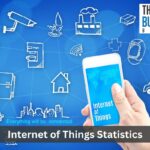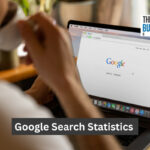Human civilization is constantly evolving.
The ability to create fire was a turning point for humanity, as was discovering electricity.
However, it can be argued that humanity has advanced far more significantly in the last fifty years thanks to the increased use and ability of technology.
It’s an ongoing process but one that appears to be picking up speed, leaving you to wonder, how fast is technology advancing in the world and if there is any end in sight.
Modern life relies on technology, it’s an integral part of daily life.
You’ll use it without realizing it.
For example, you probably set a wake-up alarm on your cell phone, and once awake check your messages.
The continuing increase in devices connected to the internet is a sign of technological advancement.
You can also look at the progress of automated vehicles, AI, and even space exploration.
The capabilities of technology are constantly evolving.
In many cases, it’s changing faster than you may think.
Let’s take a look at the facts.
Post Contents
- 1 Key Statistics
- 2 How Fast Is Technology Advancing in the World?
- 2.1 1. By 2025 There Will Be 38.6 Billion IoT Connected Devices
- 2.2 2. 90% Of The World’s Data Has been Gathered In The Last Two Years!
- 2.3 3. 600,000 People Use The Internet For The First Time Daily
- 2.4 4. By 2026 The Web Hosting Services Industry Will Have Generated $183.18 Billion
- 2.5 5. There Are Currently Over 5 Billion Unique Cell Phone Users
- 2.6 6. There Are Over 8.5 Billion Google Searches Daily
- 2.7 7. Experts believe 95% Of Purchases Will Be Online By 2040.
- 2.8 8. Machine Learning Has Improved The Google Translate Algorithm By 30%
- 2.9 9. By 2025, It’s expected AI Will Replace 85 Million Jobs In The US Alone
- 2.10 10. 58.26% Of Internet Traffic Originates From Mobile Devices
- 3 Summing Up
Key Statistics
- By 2025 there will be 38.6 billion IoT connected devices
- 90% of the world’s data has been gathered in the last two years!
- 600,000 people use the internet for the first time daily
- By 2026 the web hosting services industry will have generated $183.18 billion
- There are currently over 5 billion unique cell phone users
- There are over 8.5 billion Google searches daily
- Experts believe 95% of purchases will be online by 2040.
- Machine learning has improved the Google Translate algorithm by 30%
- By 2025, it’s expected AI will replace 85 million jobs in the US alone
- 58.26% of internet traffic originates from mobile devices
How Fast Is Technology Advancing in the World?
1. By 2025 There Will Be 38.6 Billion IoT Connected Devices

The Internet of Things is a term used to describe any item with sensors; software, and the processing ability to connect to the internet.
In essence, these devices can connect to designated software over the internet and provide regular updates regarding their situation.
The software can be used by companies to monitor vending machine sales and sticking levels, individuals to check and control the heat in their houses, and even by governments to monitor traffic conditions.
The list of applications for IoT is almost endless.
This is demonstrated by the number of IoT devices connected.
According to statistics, in 2018 there were just 7 billion IoT devices.
By 2023 there were 35 billion connected devices and it’s expected this number will rise again.
Predictions expect IoT connectivity to reach 38.6 billion by 2025 and a staggering 50 billion by 2030.
An estimated 127 new devices are connected every second across the planet!
In short, it’s just a matter of time before every device on the planet is connected and can be used remotely.
(Zippia)
2. 90% Of The World’s Data Has been Gathered In The Last Two Years!
The modern world works on data.
It’s collected from the moment you create your first account and go online.
Data is constantly being updated and it represents big business to the right companies.
What may surprise you is the speed at which data can be collected.
It’s thanks to technological advancements that 2.5 quintillion bytes of data can be collected and processed every day.
That’s too much for the human brain to conceive as the number is huge.
In a testimony to the power and advancement of technology.
The majority of data available today has only been collected in the last two years.
Estimates suggest as much as 90% of all known data has been collected in the last two years.
Much of this is thanks to the automated procedures which have been introduced, along with algorithms and bots.
The result is huge amounts of data are held on almost every person on the planet.
(Zippia)
3. 600,000 People Use The Internet For The First Time Daily
If you already use the internet daily to surf the latest news, research a project, or chat on social media, then you’re probably amazed to find that some people have never been online.
In fact, approximately 5 billion people are online out of a global population of 8 billion.
This fact is slowly being remedied as reports show 600,000 people are going online for the first time every day.
That means it could still take another ten years to get the entire planet online!
It’s worth noting that younger people have always been keener to try new technology.
In 2000, 70% of people aged between 18-29 were online.
By 2020 this has increased to 99% of people in this age bracket.
It’s not just a sign that technology is advancing quickly, it shows how willing the younger generation is to accept new technology.
(Zippia)
4. By 2026 The Web Hosting Services Industry Will Have Generated $183.18 Billion
The web hosting services industry is a good indicator of technological advancement.
After all, as increasing numbers of devices connect online there will be an increased need for hosting services.
The industry was worth $32.12 billion in 2017.
By 2018 this had increased to $60.9 billion and by 2026 it’s predicted it will be worth three times its 2018 value.
That’s a staggering $183.18 billion.
The opportunity for growth and, therefore, to generate significant incomes, explains why the web hosting services industry has become a highly competitive marketplace.
It’s a good opportunity to get a hosting deal!
(Fortune Business Insight)
5. There Are Currently Over 5 Billion Unique Cell Phone Users

According to statistics, there are roughly 8 billion people living on the planet and around 5 billion have access to the internet.
Interestingly, this corresponds to mobile phone users.
While reports suggest there are well over 7 billion mobile phones registered as in use, there are only 5.32 billion unique users.
In short, the majority of people with internet access have mobile phones.
In many cases, this is the reason why they have internet access.
The difference between users and registered unique users is simply because some people still have old phones registered to them, some have two phones, (one work and one personal), and others have needed to replace damaged phones but the old one is still registered, even if it no longer works.
It’s worth noting that the number of unique phone users has grown by just under 2% in one year.
This pattern is likely to continue as more people get online.
Four out of five new phones are smartphones.
(Data Reportal)
6. There Are Over 8.5 Billion Google Searches Daily
Perhaps the easiest way to see how many more people are using technology today is to look at how many Google searches are performed daily.
According to the latest research, over 8.5 billion searches are created on Google daily.
That’s impressive considering there are only 5 billion users.
The numbers have been steadily climbing for years.
For example, in 2021 there were just 7.81 billion searches per day.
It’s worth noting that Google dominates the search market, taking a 92.05% share.
Naturally, the US dominates the search market with 27.61% of Google traffic coming from the US.
To give an idea of how popular technology and the internet are in the US, the second largest source of Google searches is Brazil, with just 4.63% of all searches.
(Oberlo)
7. Experts believe 95% Of Purchases Will Be Online By 2040.
The internet isn’t just a great tool for staying connected to others and keeping up with work-related tasks.
It’s also the best way to purchase items.
In short, the internet is convenient.
You can shop from home at any time of the day or night.
More importantly, you can shop anywhere.
If you’re struggling to locate an item locally, you’re certain to be able to find it online, because you can effortlessly shop anywhere on the planet.
But technology isn’t just making the ordering process easier.
It’s also revolutionizing the delivery techniques, such as delivery via drone.
It’s never been easier to order from anywhere in the world and get it within hours.
These facts and the current growth rate of eCommerce tell experts that, by 2040, 95% of all your purchases will be completed online.
There just won’t be a good enough reason to visit a store.
(Nasdaq)
8. Machine Learning Has Improved The Google Translate Algorithm By 30%

Google Translate was launched in 2006.
It’s a web-based translator, allowing people to write or speak and have the phrase translated into a language of their choice.
It’s been a very useful tool for many people struggling with the language barrier.
However, in its early days, it developed a reputation for inaccuracies in translation.
This was down to the nuances of any language, something that is difficult for any program to consolidate.
That’s why, until machine learning was integrated into the app, the efficiency rate of Google Translate was just 55%.
In other words, a close to 50/50 chance of getting the right translation or not.
The integration of machine learning revolutionized the process.
Today, you won’t just get a better translation, you’ll also get it faster.
The app can now translate large pieces of text virtually instantly.
The efficiency rate has climbed by an impressive 30%, now offering an 85% efficiency rate.
That’s sure to inspire more confidence in the service and is a direct result of technological advancement.
(Finance Online)
9. By 2025, It’s expected AI Will Replace 85 Million Jobs In The US Alone
Artificial Intelligence is a controversial subject.
There is little doubt that it can drive technology further forward and that it is capable of pushing many boundaries.
However, there is also a real risk that it will overtake humanity and become a threat to our very survival.
While that is difficult to predict, experts currently believe that AI will have replaced as many as 85 million jobs in the US by 2025.
That’s roughly a quarter of the population.
Considering the amount of job losses and hardships that the pandemic created, this could be a serious issue for many workers.
It’s definitely a sign of how fast technology is moving.
It’s worth noting that experts also expect the arrival of AI in the workplace to create 95 million jobs.
Potentially all those who lose jobs could find new work, but it’s likely to involve retraining.
(Forbes)
10. 58.26% Of Internet Traffic Originates From Mobile Devices

The very first smartphones appeared in 1992 but weren’t capable of the things smartphones are today.
In fact, it took until the early 2010s for a smartphone to appear with the connectivity and processing power to allow it to be regularly used online.
Fast forward 10 years and the average smartphone is more powerful than the average desktop.
It’s also much more convenient as most people carry their phones with them at all times.
The proof of this technological advance is in the usage.
In 2010 10.88% of internet traffic came from a mobile.
It was simply too slow to be a practical option.
Today, 56.26% of internet traffic originates from a mobile device and the number is growing each year.
In another ten years, it’s likely that 95% of internet access will be mobile-based.
(Oberlo)
Summing Up
It’s difficult to give a precise answer on how fast technology is advancing in the world in 2024.
Put simply, it’s evolving rapidly.
The simple truth is that technology is advancing steadily every day and the pace is getting faster.
Things that seemed impossible a few years ago are now reality and things that seem impossible today may be reality within a year.
It’s certainly true that technology has made communication easier.
It’s also much simpler to locate information and gain an education, all you need is the internet and time.
The development of technology is completed by the involvement and acceptance of humanity.
As long as that continues, technology will continue to advance.
Who knows where it will take us.






























